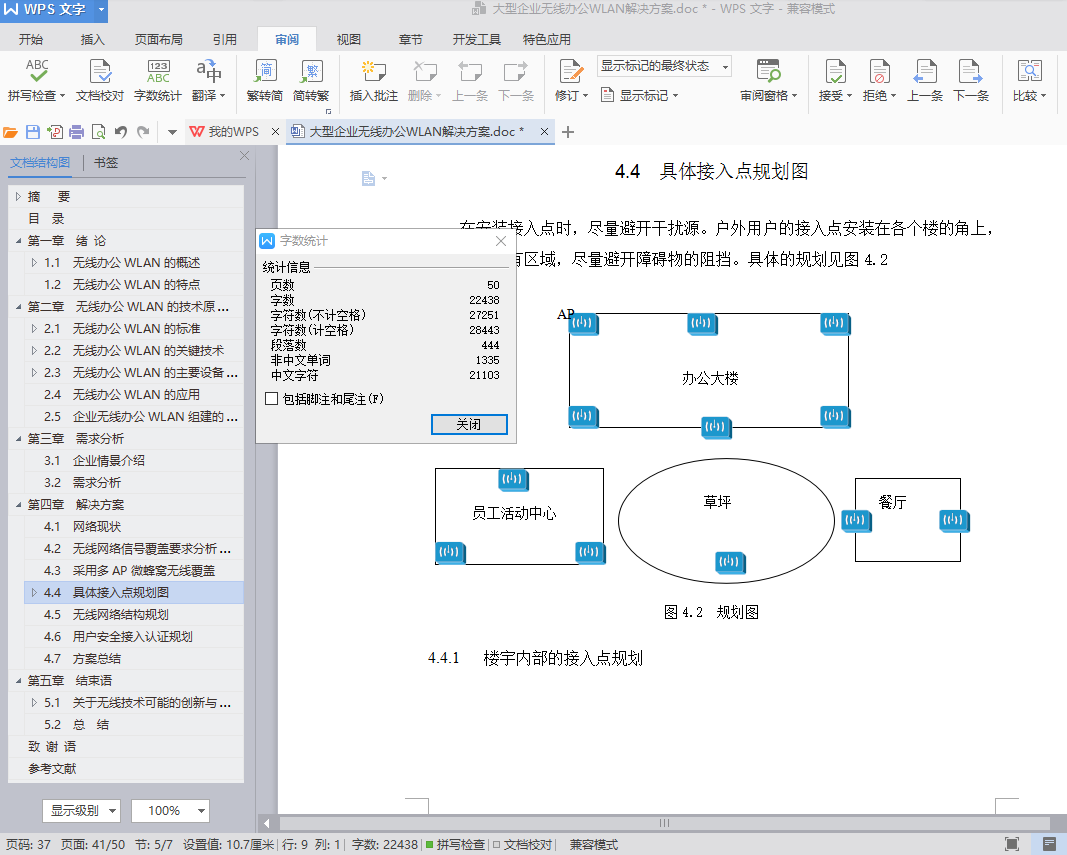摘 要
随着以太网的广泛应用,因特网的日益普及,以及移动终端的不断增加,人们日常的生活、办公对移动IP接入的需求迅速增长。无线办公WLANWLAN(Wireless Local Area Network )作为有线以太网的延伸,一定程度上满足了这种需求。
无线办公WLAN采用射频技术构成局域网络,是一种便利的数据传输系统。由于无线办公WLAN设备一般工作于免授权频段,在频段的使用上无需高昂的许可费用,加之WLAN技术的日趋成熟,使得WLAN的应用已经从单纯的有线网络的延伸拓展开来,成为小区尤其是热点地区重要的高速无线数据接入手段之一,应用潜力巨大。同时WLAN的先期部署将促进移动数据业务需求的增长和相关业务应用的成熟。
今天,无线办公WLAN的应用范围已经非常广泛,尤其是企业,随着人们对移动办公、高速工作效率的需求,使用无线网络必不可少。 可以预见,凭借无线接入技术本身具有的应用灵活、安装速度快、建设周期短等优势,以及地理应用环境的无限制特性,WLAN必将作为一种高速无线数据接入手段与有线网络一起,构成灵活、高效、完善的宽带网络。
关键词: 无线办公WLAN WLAN技术原理 WLAN的规划设计
ABSTRACT
With the extensive application of Ethernet, the increasing popularity of the Internet, and mobile terminals continue to increase, people daily life, office mobile IP access on the rapidly growing demand. Wireless LAN WLAN (Wireless Local Area Network) as an extension of wired Ethernet, to a certain extent to meet this demand.
Wireless Local Area Network constitutes a local area network using radio frequency technology, is a convenient data transmission system. As wireless LAN devices generally work in the unlicensed bands, in the band without the use of high license fees, combined with WLAN technology has matured, making WLAN applications has grown from a simple extension of wired networks open up, become especially hot cell region is an important means of high-speed wireless data access, application potential. The early deployment of WLAN will also promote the growth of demand for mobile data services and related business applications mature.
Today, wireless local area network has a very wide range of applications, particularly in business, as people move office, the demand for high efficiency, the use of wireless networks is essential. Can be expected, with wireless access technology itself is the application of a flexible, quick installation, short construction period, advantages, and application environment of unlimited geographic features, WLAN will as a high-speed wireless data access tools, together with the wired network, constitute a flexible, efficient, improve the broadband network.
Keywords: WLAN WLAN technology WLAN planning and design principles
目 录
第一章 绪 论 1
1.1 无线办公WLAN的概述 1
1.1.1 概念 1
1.1.2 采用非专用频段 2
1.2 无线办公WLAN的特点 3
第二章 无线办公WLAN的技术原理 7
2.1 无线办公WLAN的标准 7
2.1.1 IEEE802.11 7
2.1.1.1 IEEE802.11b 8
2.1.1.2 IEEE802.11a 8
2.1.1.3 IEEE802.11g 8
2.1.1.4 IEEE802.11n 9
2.1.2 IEEE802.11e协议 9
2.1.2.1 概述 9
2.1.2.2 IEEE802.11MAC协议 9
2.1.2.3 IEEE802.11e的EDCF机制 10
2.2 无线办公WLAN的关键技术 10
2.2.1 IEEE802.11无线办公WLAN的物理层关键技术 12
2.2.1.1 DSSS调制技术 11
2.2.1.2 PBCC调制技术 11
2.2.1.3 OFDM技术 11
2.2.1.4 MIMO+OFDM技术 13
2.2.2 无线办公WLAN的数据链路层关键技术 15
2.2.2.1 无线办公WLAN的MAC子层工作方式 16
2.3 无线办公WLAN的主要设备和拓扑结构 20
2.3.1 主要设备介绍 20
2.3.2 拓扑结构 22
2.4 无线办公WLAN的应用 28
2.5 企业无线办公WLAN组建的建议 31
第三章 需求分析 33
3.1 企业情景介绍 33
3.2 需求分析 33
第四章 解决方案 35
4.1 网络现状 35
4.2 无线网络信号覆盖要求分析与设计 36
4.3 采用多AP微蜂窝无线覆盖 37
4.4 具体接入点规划图 37
4.4.1 楼宇内部的接入点规划 38
4.4.2 户外楼宇间照射规划与部署 38
4.4.3 户外公共场所照射规划与部署 39
4.5 无线网络结构规划 39
4.6 用户安全接入认证规划 40
4.7 方案总结 42
第五章 结束语 43
5.1 关于无线技术可能的创新与不足 43
5.1.1 不足 43
5.1.2 创新 43
5.2 总 结 44
致 谢 语 45
参考文献 47




